Pro: Pick up the spatula
by, Gina Wong
As humans, we need food to survive, and cooking our own meals is one way for college students to save money and control their diets.
Pierce College should offer cooking classes because it can attract students who have aspirations to become a chef and can act as a possible solution to the food security issue that the school is facing.
According to nationalschools.com, “Learning how to cook is fun, but it can lead to the beginning of a thriving career because the courses are a career prep for students looking to make their mark in the culinary arts.”
Pierce adding a culinary arts program to its offered majors can be easily implemented either as a new major or through the Pierce Extension Program.
Furthermore, Pierce is missing out because other local schools have cooking classes already in place. These schools are Glendale Community College, Pasadena City College, and Los Angeles City College.
Plus, the demand for professional chefs is expected to grow 10 percent by 2023, according to collegechoice.net.
The advantage of a community college offering cooking classes and degrees in that field of study is that it allows students to be able to further their education and life skills.
They can take general education courses while still being able to take their major classes, whereas going straight to a culinary school does not give them these opportunities.
However, not only would the addition of a culinary arts program benefit students interested in the field, but it can also benefit the everyday student if it were added to the arts section in the IGETC program.
Cooking is a life skill and learning how to cook is beneficial to everybody because it will help people save money in the long run.For instance, eating out twice a day will put a hole in your wallet, especially now that food prices keep rising.
Also, it is important to keep in mind that even though fast food is often cheaper, too much consumption of this type of food is not healthy for an individual’s well-being.
According to a study published in the journal Public Health Nutrition, “People who frequently cook dinner at home eat healthier and consume fewer calories than those who cook less.”
Moreover, cooking allows people to consciously keep track of their food intake and diets mainly because the person who is doing the cooking is able to see what ingredients are actually being used and how much of it.
One of the outcomes for students who enroll in a cooking class is that it will help them step outside of their comfort zone.
According to WebMD.com, even though the majority of people eat dinner at home, less than 60 percent of the people actually prepared the meal in their own kitchen.
This percentage can be decreased if there was a class where students can learn how to cook and prepare a meal, allowing them to feel more comfortable in a kitchen.
One of the concerns that could arise in the implementation of a cooking class is that it will have low enrollment, but this may not be the case. Now the male to female ratio in culinary schools is almost equal.
Cooking classes can benefit Pierce because the foods served at events that take place at the Great Hall are funded by the ASO. However, if a culinary arts class was offered, the advanced foods class could instead contribute by baking cookies or cupcakes.
If Pierce had a culinary arts program, it can relieve the food security issue for students who feel on-campus food is expensive. They can enroll in a cooking class, learn how to cook and won’t go hungry because they will have the right knowledge.
Con: Stay out of the kitchen
by, Jackson Hayano
Cooking can be a fun and educational activity, but that doesn’t mean Pierce College should be shelling out dollars on these type of classes.
Out of the nine colleges in the Los Angeles Community College District (LACCD), only three of them offer courses in culinary arts.
However, very few of these classes involve actual “cooking.” Most of the classes revolve around things such as restaurant management, menu planning and catering.
Only a few classes actually involve learning how to cook. This shows that cooking classes are in low demand across the district. Why bring cooking classes to Pierce when they clearly aren’t that popular for enrollment?
Also, there is no place on campus where a cooking class could be held. In order to teach these cooking classes, the school would have to form a whole new department and designate a new space to properly apply its curriculum. Expensive appliances such as ovens, grills and stoves would have to be installed.
Not to mention, money would have to be spent on pots, pans and other kinds of cooking utensils. Food and ingredients would also have to be bought and transported to Pierce. There would also have to be some sort of refrigeration and storage to keep foods from spoiling or rotting. However, there are some well-established refrigeration companies out there supplying the commercial sector and so getting hold of the necessary refrigeration technology should not be too difficult to do. Those in the restaurant industry use the services of such companies on a regular basis but there are conflicting opinions on whether or not it would be suitable for the purpose described in this article.
The cost for all this would simply be too much.
Aside from the funding, the possible accidents and incidents that might happen in a cooking class should also be taken into account. Students might get cut, burnt or sliced while preparing a meal.
In order to have a cooking class, Pierce would need to hire new teachers who are experienced in the field. Time and energy would have to be exhausted to create a curriculum for students to follow.
In today’s society, students follow a wide variety of diets. Vegans, vegetarians and pescatarians are just to name a few.
Given the many different types of lifestyles, finding a specific cooking class that caters to one’s preferred diet might be more difficult than it sounds. Plus, the program would have to compensate for the numerous allergies that students might have.
Pierce is having problems with enrollment as it is. Some classes are even resorting to online advertising to get enough students to fill the empty spaces.
With the low demand for cooking classes in general, chances are these courses won’t be too popular and they won’t attract many new students.
According to marketwatch.com, “Student enrollment in Family and Consumer Sciences classes, often called “home economics,” has declined almost 40 percent in the last decade.”
Students just aren’t interested in cooking classes.
Those who are interested in practicing cooking beyond their home can just go on YouTube and watch tutorials for free. If students want a more hands-on learning, they can just sign up for cooking classes at a local recreational center.
And of course, students who are really interested in professionally pursuing a career in culinary arts can just apply to a special school.
While learning how to cook is a valuable tool, it simply isn’t a viable class to offer here at Pierce. There are just too many logistics and financial costs that make having cooking classes on campus unfeasible.



